|
|
The Blue Followers: the
Placidochromis of Lake Malawi
|
By Daniela Rizzo |
Among hobbyists there are many fans of Malawi cichlids captured by their
amazing colours and their vivacious behavior. The aufwuchs-grazing
mbuna that dwell in the rocky parts of the lake are particularly well-known,
including many commonly traded species of Melanochromis and
Pseudotropheus. Although aggressive, they are colourful and generally easy
to maintain, and provided you follow a few simple rules, they are normally easy
to breed.
But if you want a less rough-and-tumble aquarium than one housing mbuna,
that doesn’t mean you have to give up on bright colour and enchanting
behaviours! There are plenty of other cichlids in Lake Malawi that provide both
bright colours and interesting behaviours, and one genus in particular,
Placidochromis, is the focus of this article. The genus Placidochromis
contains a number of species widely distributed across the lake, living in the
so-called ‘intermediate habitat’, shallow water areas usually less than 30
metres in depth and containing both sand and rocks on the substrate.
Placidochromis mostly feed on invertebrates found in the sand, but not all
species have exactly the same habits, so it’s important to review each species
in detail.
Placidochromis phenochilus and Placidochromis
electra
Within the genus Placidochromis there is one group of species
regarded by ichthyologists as closely related. This group consists of
Placidochromis electra (probably the most frequently imported species) and
Placidochromis phenochilus, along with its geographical populations.
Previously both these species were considered to be part of a single variable
species, but taxonomists now consider them to
be distinct.
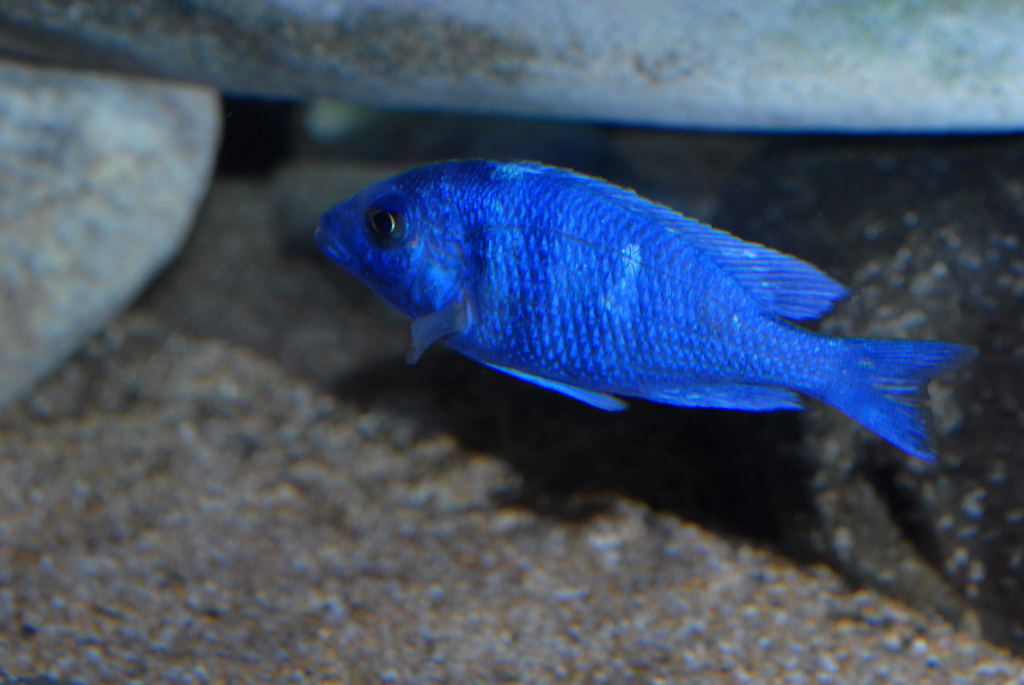
“A male Placidochromis
phenochilus”
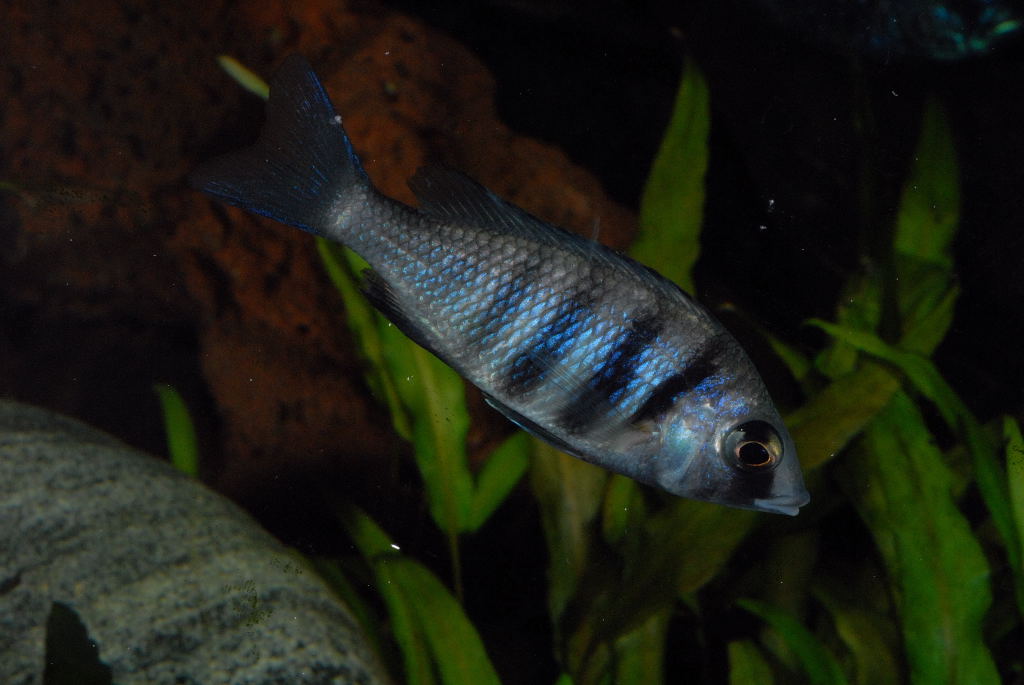
“A young female
Placidochromis phenochilus”
Placidochromis phenochilus lives only in the northern part of Lake
Malawi and can be easily recognised by its white lips. Adult males display a
distinctive pattern of pearly white spots against a blue body colour, probably
caused by an otherwise harmless virus. Because of its lovely colours, this
species has become very popular among aquarists. Placidochromis phenochilus
are known as “Blue Followers” because of an unusual feeding strategy this
species has adopted. In open sand areas of the lake, the big cichlid
Taeniolethrinops orbitalis looks for food by filtering the sands through
its gills, in the process stirring up a lot of detritus. Placidochromis
phenochilus follows these Taeniolethrinops around, consuming the
invertebrates and other edible particles revealed in the sifted sand.
Placidochromis phenochilus isn’t the only species that feeds in this way;
other species known to exhibit this behaviour include Cyrtocara moori,
Protomelas annctens and Otopharynx selenurus.
In some parts of the lake Placidochromis electra also spends some of
the time following sand-sifting cichlids such as Taeniolethrinops
orbitalis and Fossorochromis rostratus to find food, but in other
parts of the lake it lives among the rocks defending permanent territories. Like
Placidochromis phenochilus, this cichlid is blue, which would seemingly
make both of them obvious targets for predatory fish patrolling open sandy
areas. One theory is that their blue colour discourages other fishes from
joining the group following the large sand-sifting cichlid, the idea being that
if too many fish are in the group, then there will not be enough food to go
around.
Placidochromis sp.“gisseli”
A new addition to the Malawi cichlid trade is the fish known as
Placidochromis sp.“gisseli”. It resembles Placidochromis
phenochilus in terms of appearance and behaviour, but can be distinguished
by its black cheeks. While traded as a separate fish, it has not yet recognised
as a distinct species, and in terms of maintenance it is very similar to
Placidochromis phenochilus.
Blue followers in the aquarium
Imagine how interesting it would be to observe a group of blue followers
in your aquarium! The good news is that it is certainly possible, though you
will need an aquarium at least 200 cm (about 6 feet) long for a pair of
Taeniolethrinops orbitalis, a group of four Otopharynx
selenurus and four Placidochromis phenochilus or
Placidochromis electra. As is often the case with closely related cichlids,
you shouldn’t keep the two Placidochromis species together because they
will hybridise.
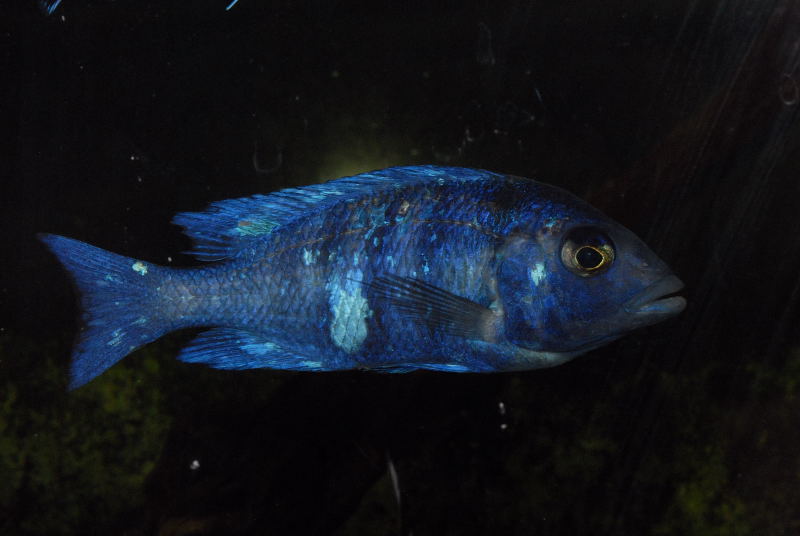
“This male Placidochromis
phenochilus ‘Tanzania’ demonstrates how populations in each part of the
lake can be morphologically and genetically distinct”
Decorate the tank with fine sand on the bottom and add a few rocks
around the edges of the tank to create some hiding places. Of course the water
must be clear and hard: aim for pH 8, hardness around 20 degrees dH. Although a
strong water current is not required, the filter outflow must create good water
circulation because of the sensitivity of these fish to poor water quality and
low oxygen concentrations.
Placidochromis aren’t big fishes, and in the wild they rarely exceed 15
cm. Like many other Malawian cichlids they can get a bit bigger in the aquarium
because they will eat a lot and are easily overfed. Be careful to give them
small amounts of food. Remember, if your fishes don’t eat one day per week, that
will actually keep them healthy, though the cichlids themselves might complain!
Choose flake or pellet foods with a low fat content, and supplement their diet
with invertebrates such as mysis, cyclops, krill and daphnia. In common with
many other cichlids, some vegetable matter including spirulina flake is
important for good health, though these fish don’t show as much enthusiasm for
such foods as they do invertebrates.
It has been said that high protein live foods are not good for these
fish when used excessively. But live foods such as artemia and mosquito larvae
make good treats that can be offered every week or two. During the summer I put
my cichlids in an outdoor pond full of Chironomus and mosquito larvae,
and the fish eagerly devoured them without coming to any harm. It might make a
difference that they were in a more natural habitat, with more space for
swimming and more work to be done as they hunt for food. They also need to be
more active and wary so that they could avoid predators such as herons - the
struggle for existence! In any case, because I live in Rome where the winter is
too cold for them, I have to bring them back indoors by October. I find that
they have grown during the summer, and have particularly bright colours.
Community tank behaviour
If you aren’t enchanted by the blue followers community you can keep
Placidochromis phenochilus and Placidochromis electra in Malawi
communities as well, though as mentioned before, not both species together
because of the danger of hybridisation.
An aquarium 160 cm (about 5.5 feet) long is the minimum for these fishes
because they need lots of space to swim around. A fine sand substrate with a
rocky area near the back is recommended, and if you want plants, choose species
like Vallisneria and Anubias that will tolerate their digging.
Put the plants near the back of the tank, taking care to leave lots of free
swimming space.
These two Placidochromis species aren’t particularly aggressive
towards conspecifics but it is best to maintain them in groups of at least
three, one male to every two females. They can cohabit well with Aulonocara,
Protomelas and Copadichromis. On the other hand, being
comparatively gentle fish, they find living with mbuna including
Melanochromis and Pseudotropheus just too hard, and you’ll
certainly stop them from breeding or behaving normally.
Reproduction
Placidochromis are maternal mouthbrooders. Taking
Placidochromis phenochilus as an example, the courtship is relatively
short. The male doesn’t dig a pit or defend a nest or a territory; instead he
goes toward a female, they swim in a circle, and then the female lays an egg and
takes it into her mouth. This is repeated many times until she has laid and
collected all her eggs, at which point the male fertilises the eggs in her
mouth.
Spawning concluded, the female seeks a refuge such as a clump of plants
or a cave. Usually the female mates with only one male at a time, but the males
are polygamous and will try and breed with all females in the tank.
Mouthbrooding females don’t school together like Cyprichromis, but
remain hidden for around 24 days, during which time they do not feed. When she
has finished incubating the eggs and fry, she releases 25 tiny grey-coloured
Placidochromis fry a mere half centimeter long.
I have never seen any post-release care from the mother. The fry swim
quickly toward the bottom where they remain hidden among rocks and plants,
darting out briefly to snap up food. The fry are quite easy to rear on various
types of food including brine shrimp nauplii and powdered fry foods. Sinking
tablet foods are also a useful food for rearing these fish. In most community
tanks very few fry will survive, but if you want to rear the fry yourself, it is
best to remove a mouthbrooding female to another tank and wait for her to
naturally release her fry when she’s ready to do so. Don’t try and force her to
spit out her fry! Placidochromis fry grow slowly, but by around eight
months of age they will resemble to their parents.
Placidochromis phenochilus is an interesting fish worth keeping,
but it is often difficult to get good quality stock. Where possible, breeders
will want to known the geographical origin of the specimens on sale so that they
can avoid interbreeding different lineages and ensure that the fry they produce
are typical of one particular geographical variant. Although it may be hard
finding positively identified fish in your area, the various cichlid
associations around the world may be able to help.
Placidochromis johnstoni “gold”
If the blue follower Placidochromis aren’t for you, then
consider a lesser known species, Placidochromis johnstoni. This species
is widespread in shallow bays thick with beds of Vallisneria,
Potamogeton and Ceratophyllum. Large groups of these fish forage
in the vegetation, picking up invertebrates and detritus in a curious manner:
the fish snaps its mouth on the substrate, creating a cloud of debris from which
particles of food are collected and eaten. Within the group, only the dominant
male shows its breeding colours, even though he doesn’t establish a territory or
build a nest.
Placidochromis johnstoni “gold” lives in rocky areas with sandy
bottoms. Like other Placidochromis johnstoni it snaps it mouth to stir
up detritus, but besides invertebrates it also attracts juvenile mbuna that are
promptly caught and eaten!
A final variety of Placidochromis johnstoni sometimes traded is
Placidochromis johnstoni “solo”, so called because it is solitary rather
than gregarious species. Since they do not live in groups, the breeding males do
not need to display their dominance with displays of colour, and consequently it
is rare to find a males in their breeding colouration in the wild. Although
widespread, this species lives mostly in areas with a pebbly substrate. Its diet
consists of invertebrates and algae picked from the pebbles. In aquarium this
species has been reported to be rather aggressive towards conspecifics, but my
own trio of two males and one female have coexisted for the last three years
without any obvious fighting.
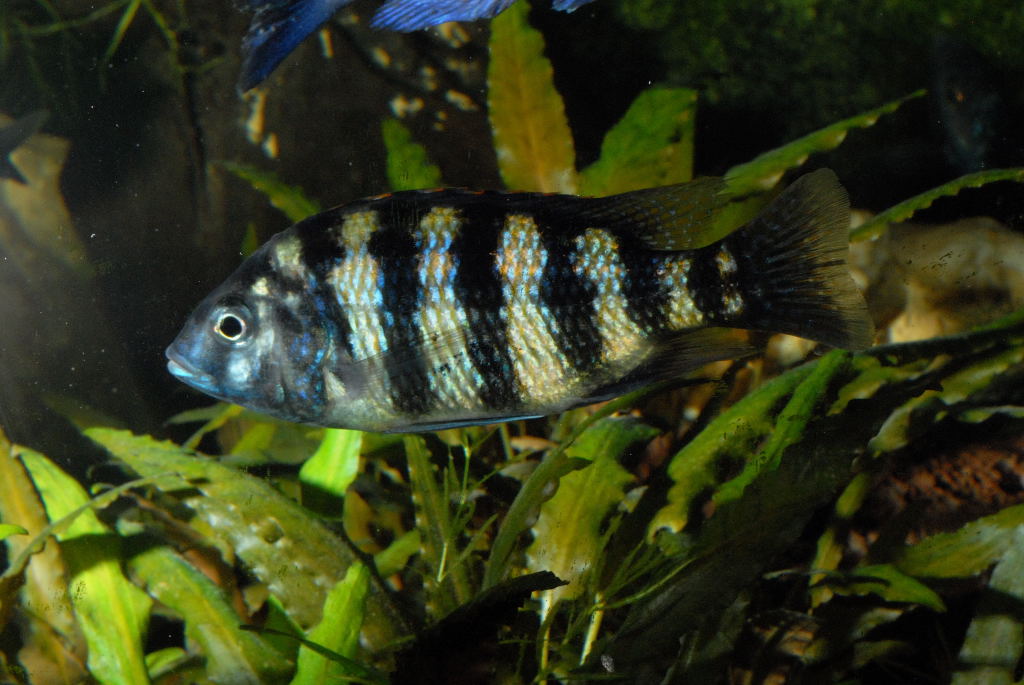
“Male Placidochromis
johnstoni ‘solo’ at first glance look a lot like the females”
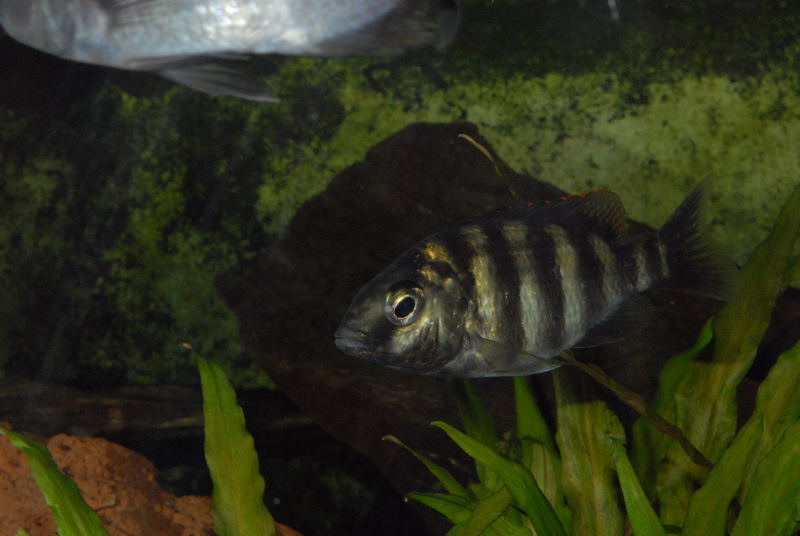
“Female Placidochromis
johnstoni ‘solo’ are a bit darker than males and lack the blue sheen”
When the female Placidochromis johnstoni “solo” is ready to
spawn, she swims in front of the dominant male and breeding takes place. Under
aquarium conditions at least, the mouthbrooding female doesn’t try to hide
herself and she is ignored by males. After 25 to 28 days she will release up to
20 fry, after which she no longer takes them into her mouth and doesn’t exhibit
any other kinds of brood care either. The fry can be fed with the same foods as
the adults.
Placidochromis johnstoni “solo” reaches a length of 15 cm and in
common with other members of the genus needs a lot of swimming space. An
aquarium 150 cm (about 5 feet) in length should be considered the minimum sized
tank for this species. It will cohabit with species such as Hemitilapia,
Protomelas similis and the more peaceful mbuna like Labidochromis
and Iodotropheus. In my 200 cm tank Placidochromis johnstoni
“solo” coexist with Copadichromis azureus, Aulonocara sp.
“Lwanda”, Otopharynx “Golden Blue Face” and young Melanochromis
cyaeneorhabdos without problems. The only obvious shortcoming is that the
males refuse to assume their breeding colouration.
Placidochromis johnstoni “solo” appreciate the shade and shelter
offered by plants, and these should be used where possible. I find that
Vallisneria, Anubias and Cryptocoryne live well in the
hard, alkaline water these fish need. Favourite foods include krill, cyclops,
artemia, daphnia, copepods and other invertebrates, but as with other
Placidochromis, don’t forget to give them some vegetable flakes too!
Other Placidochromis
A few other species of Placidochromis are infrequently imported.
One of these is the shallow water species Placidochromis longimanus
normally found among Ceratophyllum and Vallisneria beds. It is
primarily herbivorous, consuming algae and soft plants, so shouldn’t be given
too many of the invertebrate foods the other species enjoy. Instead concentrate
on providing it with a diet rich in greens, similar to the sort of diet offered
to cichlids such as Tropheus. Needless to say it is best kept in tanks
with sturdy, fast-growing plants that it can’t damage, for example the large
species of Vallisneria.
Placidochromis milomo is a species well known for his enlarged
lips. Among some aquarists it is known as the Super VC-10 cichlid, the name
being taken from an old jet airliner that used to fly between England and
Malawi, after an early collector was surprised by the jet-like speed with which
the fish escaped his net! It normally lives in deep, rocky habitats where it
sometimes employs a very distinctive mode of feeding. It presses its thick lips
against rocky crevices and then literally sucks in any invertebrates of baby
fish hiding there. Curiously, the more often or more forcefully this fish uses
its suction feeding mode, the thicker its lips become! Under aquarium conditions
it does not need any particular care in terms of feeding, and readily takes the
same foods as any other Placidochromis.
Reaching 20 cm of length Placidochromis milomo consequently
needs a large aquarium, though it seldom it establishes a territory or defends a
nest among the rocks. In part because of its larger size, this is one of the
Placidochromis that gets along reasonably well with mbuna, provided it
isn’t kept with exceptionally aggressive species such as those to be found among
the genera Labeotropheus, Melanochromis or Pseudotropheus.
General care of other Placidochromis
Like the Blue Followers, these other Placidochromis do best in large
tanks, and the minimum recommended aquarium is one 150 x 50 x 50 cm in size
(approximately 100 US gallons). The substrate should consist of a bed of fine
sand broken up with groups of rocks and clumps of plants. As with other Malawian
cichlids, the water quality needs to be excellent, and close attention should be
paid to the water chemistry as well, with a pH of 8 and a general hardness of at
least 18 degrees dH being required. Water temperature should be around 23-25
degrees C (74-77 degrees F). Regular water changes are important, and should be
at least 10% per week.
Placidochromis are best kept in groups of one male to two females,
and tankmates should be relatively peaceful Malawians, with the more aggressive
and territorial species carefully avoided. Labeotropheus,
Melanochromis or Pseudotropheus are not good companions for the
relatively easy-going Placidochromis, but things like Aulonocara,
Copadichromis, Hemitilapia and Otopharynx usually work
well.
In common with the Blue Followers, give your Placidochromis a
good and varied diet. Flake and pellet foods that are low in fat are ideal,
supplemented with frozen foods such as krill, cyclops and mysis. In terms of
live foods, things like daphnia and brine shrimp are readily taken. Feed
sparingly, and take care to include at least some green foods in their diet.
This is particularly important in the case of herbivorous species like
Placidochromis longimanus. By following these rules you will make sure your
fish never suffer from the dreading Malawi Bloat, and because your fish will be
happy and healthy, they will soon reward you with lots of babies!
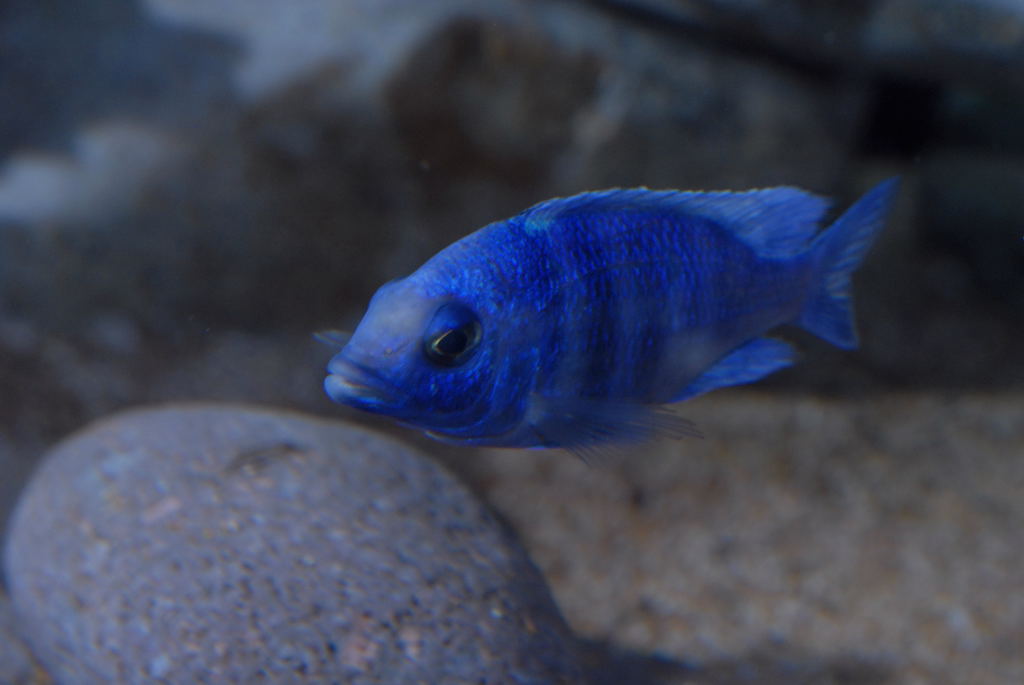
“This sub-adult male
Placidochromis phenochilus is starting to display the stunning blue
colouration typical of the species”
Placidochromis are wonderfully interesting cichlids as well as
being very beautiful and comparatively easy to keep. They are well worth hunting
down, and if your local shop can’t get some in for your, don’t forget to contact
your state or national cichlid association and see if they can put you in touch
with a local breeder.
Reference
Konings, A. (1995) Malawi Cichlids in their natural habitat. Cichlid
Press.
African Cichlids on WWM
Related Articles:
African
Cichlids,
Malawian Cichlids:
The Mbuna and their Allies
By Neale Monks,
Stocking Lake
Malawi Community Tanks by Mary Bailey,
Cichlid Fishes,
Related FAQs:
African Cichlid Reproduction 1,
African
Cichlids,
African Cichlid Identification,
African
Cichlid Selection,
African
Cichlid Selection,
African
Cichlid Compatibility,
African
Cichlid Systems,
African Cichlid Feeding,
African
Cichlid Reproduction,
African
Cichlid Disease,
Cichlids of the World, Cichlid
Systems,
Cichlid
Identification,
Cichlid
Behavior,
Cichlid Compatibility,
Cichlid
Selection,
Cichlid
Feeding,
Cichlid
Disease, Cichlid
Reproduction,
|
|
|
|
|
|
